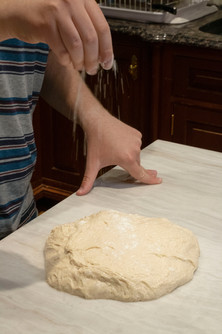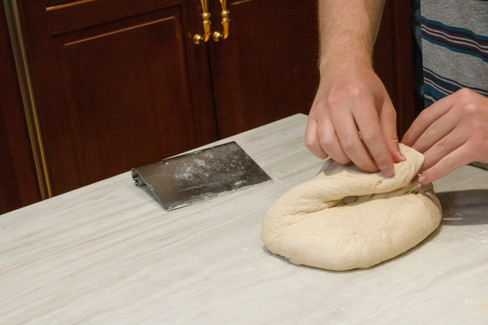Simple Non-Sourdough Bread
- Aaron Gruen
- May 23, 2021
- 3 min read
Updated: May 25, 2021

Though this bread lacks some of the flavor and texture of sourdough, it comes together incredibly quickly. If you start prepping the bread at 10 AM, you’ll have a loaf by 6PM the same day—just in time for dinner. The dough uses bread flour for structure and whole wheat flour for flavor. Only a small amount of yeast is used, allowing time for the flavors to develop and gluten chains to form. Some apple cider vinegar is added to supplement the sourdough tang and improve dough strength with hydrogen bonds. A knead before bulk fermentation and folds throughout the long rise create an airy, open-crumbed loaf. Sorry, but you won’t get a no-knead recipe from me.
Makes 1 medium loaf
Ingredients
350g water
½ tsp instant yeast
450g bread flour
50g whole wheat flour
10g Diamond Crystal kosher salt
15g water
½ tsp apple cider vinegar
¾ cup assorted dried fruit, nuts, olives, dry cheese, chocolate, or any mix-in (optional)
In a large bowl, whisk together the yeast and water. Add the bread and whole wheat flours, and mix with a spatula or by hand until all flour is incorporated. Cover with a dish towel or plastic wrap and let rest at room temperature for 30 minutes.
While the dough is resting, stir together the kosher salt, water, and vinegar in a small bowl. Once the dough has rested for 30 minutes, pour the mixture atop the dough, and using your fingers, pinch the salt into the dough (see video below).
Incorporating the salt
Push the dough and fold it over itself in the bowl until it passes the windowpane test (see below), around 10 minutes.

This dough passes the windowpane test
Form the dough into a ball, place back in the bowl it was kneaded and mixed in, cover with a dish towel, and let rise for 1 hour.
Forming the dough into a ball
After an hour, fold the dough over itself 6 times. If adding mix-ins, add them now and incorporate into the dough as you fold the bread. Cover and let rest for another 3 hours, folding 6 times every hour.
Folding the bread
When the dough has been resting for 4 hours total, lightly flour the counter and turn the dough onto the countertop. Using your hands, form the dough into a taught ball (you should be able to touch the surface of the dough momentarily without it sticking to your finger). Cover with a dish towel and let rest for 30 minutes.
The first shaping
While the dough is resting, line a banneton or colander with a cloth dish towel, then dust it liberally with flour. When the dough has rested for 30 minutes, use a bench scraper to flip the mound over. Fold the bottom third over the dough, then fold the sides over the center. Roll the dough over so the smooth side is facing up again (see the video for directions). Place the dough smooth-side down in the banneton. Cover the dough by folding the towel over the loaf, and place in the refrigerator for at least 2 hours, and up to 24 hours.

The final shaping
45 minutes before baking, place a large dutch oven with the cover on in the center rack of the oven and heat to 500°F. Once the bread has rested, flip the loaf onto a sheet of parchment paper. Brush excess flour off the surface of the loaf, and with a bread lame or knife, score the loaf once around ¾” deep at a low angle. Remove the dutch oven from the oven, carefully place the loaf inside, and cover with the lid. Return to the oven, reduce oven temperature to 475°F, and bake for 20 minutes.
Scoring and placing the bread in the dutch oven
Once the bread has been baking for 20 minutes, remove the top from the dutch oven. The bread should have expanded and will be lightly browned.

The loaf after 20 minutes
Remove the lid from the dutch oven and continue to bake for 10-15 minutes, or until the bread is uniformly golden brown. Remove the bread from the dutch oven and let cool completely on a wire rack. Do not slice the loaf until it is completely cooled. Serve.

The finished loaf
























Comments